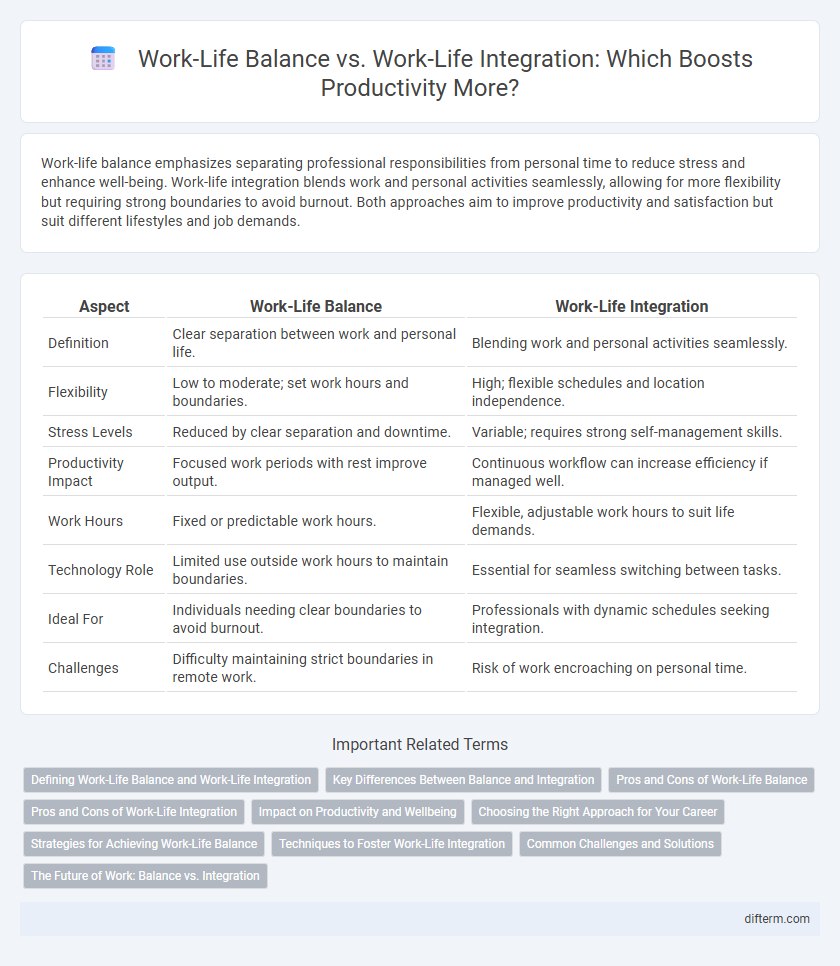Work-life balance emphasizes separating professional responsibilities from personal time to reduce stress and enhance well-being. Work-life integration blends work and personal activities seamlessly, allowing for more flexibility but requiring strong boundaries to avoid burnout. Both approaches aim to improve productivity and satisfaction but suit different lifestyles and job demands.
Table of Comparison
| Aspect | Work-Life Balance | Work-Life Integration |
|---|---|---|
| Definition | Clear separation between work and personal life. | Blending work and personal activities seamlessly. |
| Flexibility | Low to moderate; set work hours and boundaries. | High; flexible schedules and location independence. |
| Stress Levels | Reduced by clear separation and downtime. | Variable; requires strong self-management skills. |
| Productivity Impact | Focused work periods with rest improve output. | Continuous workflow can increase efficiency if managed well. |
| Work Hours | Fixed or predictable work hours. | Flexible, adjustable work hours to suit life demands. |
| Technology Role | Limited use outside work hours to maintain boundaries. | Essential for seamless switching between tasks. |
| Ideal For | Individuals needing clear boundaries to avoid burnout. | Professionals with dynamic schedules seeking integration. |
| Challenges | Difficulty maintaining strict boundaries in remote work. | Risk of work encroaching on personal time. |
Defining Work-Life Balance and Work-Life Integration
Work-life balance refers to the clear separation between professional responsibilities and personal time, ensuring dedicated periods for relaxation and family. Work-life integration blends work and personal activities more fluidly, allowing flexibility to manage both simultaneously throughout the day. This approach leverages technology and adaptable schedules to create a harmonious coexistence of career and personal life demands.
Key Differences Between Balance and Integration
Work-life balance emphasizes distinct separation between professional duties and personal life, ensuring dedicated time for each to prevent burnout, whereas work-life integration blends work and personal responsibilities seamlessly to allow flexibility throughout the day. Balance typically involves setting strict boundaries and fixed schedules, while integration encourages adaptive routines that accommodate overlapping activities, such as remote work or family involvement during work hours. Key differences include the degree of boundary rigidity, scheduling approach, and the overall flexibility in managing time across work and personal domains.
Pros and Cons of Work-Life Balance
Work-life balance promotes clear boundaries between professional and personal time, reducing stress and preventing burnout by encouraging set working hours and dedicated leisure periods. However, rigid separation can limit flexibility and hinder the seamless blending of tasks, potentially reducing productivity and adaptability in dynamic work environments. This approach benefits employees seeking structure but may challenge those needing more fluid schedules to accommodate varying responsibilities.
Pros and Cons of Work-Life Integration
Work-life integration offers flexibility by blending professional and personal responsibilities, enabling individuals to manage tasks throughout the day, which can increase productivity and reduce stress. However, it risks blurring boundaries, leading to potential burnout and difficulty disconnecting from work, negatively impacting mental health. Balancing these factors requires clear routines and technology management to maintain efficiency without sacrificing personal well-being.
Impact on Productivity and Wellbeing
Work-life integration fosters continuous alignment between professional and personal responsibilities, enhancing productivity by reducing stress and allowing flexible task management throughout the day. In contrast, strict work-life balance often creates rigid boundaries that can lead to burnout when demands in one area spike, negatively impacting overall wellbeing. Prioritizing work-life integration supports sustained mental health and efficiency, driving long-term professional performance and personal satisfaction.
Choosing the Right Approach for Your Career
Work-life balance emphasizes clear boundaries between professional and personal time, promoting mental well-being and reducing burnout by ensuring dedicated focus in each area. Work-life integration blends career and personal responsibilities, allowing flexibility and adaptability through seamless transitions between tasks based on real-time priorities. Choosing the right approach depends on individual career goals, job demands, and personal preferences to maximize productivity and overall satisfaction.
Strategies for Achieving Work-Life Balance
Effective strategies for achieving work-life balance include setting clear boundaries between work and personal time, prioritizing tasks based on urgency and importance, and incorporating regular breaks to prevent burnout. Utilizing time management tools such as calendars and productivity apps enhances efficiency and ensures dedicated time for family and self-care. Organizations that promote flexible work hours and remote work options significantly support employees in maintaining a healthy work-life balance.
Techniques to Foster Work-Life Integration
Techniques to foster work-life integration include flexible scheduling, which allows employees to adjust work hours around personal commitments, enhancing overall productivity. Leveraging digital tools such as project management apps and communication platforms helps maintain seamless collaboration between professional and personal tasks. Establishing clear boundaries and prioritizing tasks using time-blocking methods supports sustained focus and reduces burnout risks.
Common Challenges and Solutions
Work-life balance often faces challenges such as rigid schedules and stress from compartmentalizing roles, while work-life integration struggles with blurred boundaries leading to burnout and distraction. Solutions include setting clear priorities, using technology to streamline tasks, and establishing flexible routines that respect personal and professional demands. Emphasizing communication and time management tools enhances productivity and well-being in both approaches.
The Future of Work: Balance vs. Integration
Work-life integration emphasizes blending professional and personal responsibilities through flexible schedules and technology, promoting continuous productivity and well-being. Work-life balance advocates for clear boundaries and designated time for work and leisure to prevent burnout and improve focus. The future of work leans toward integration models supported by digital tools and remote work policies, enabling employees to adapt their workflows to individual lifestyles while maintaining high performance.
work-life balance vs work-life integration Infographic

 difterm.com
difterm.com